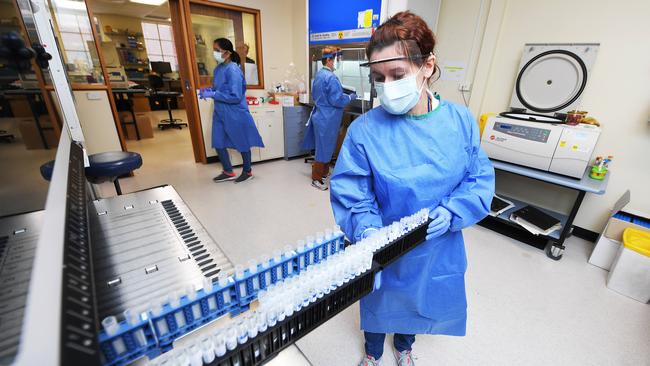COVID-19 laboratory tests explained after false positive test
Confused about how a positive SA test suddenly became a negative? We checked in with the experts who know just what goes on behind the scenes in a screening lab.
Coronavirus News
Don't miss out on the headlines from Coronavirus News. Followed categories will be added to My News.
- Relief as SA positive case proves negative
- Latest subscriber-exclusive giveaways, specials and prizes
One positive COVID-19 case with dire implications for the state suddenly became negative overnight. If you’re wondering how that can happen, our comprehensive Q&A below explains from the points of view of the experts themselves.
What is the test used to diagnose COVID-19?
The nucleic acid amplification test aims to detect the presence of genetic material (nucleic acid) from the virus in a swab, which is usually taken from high in the nose and the back of the throat.
If the SARS-CoV-2 virus is present, a short sequence of genetic material in the form of RNA is converted into DNA using the enzyme “reverse transcriptase”.
The sequence is then copied many times in a Polymerase Chain Reaction (PCR), to amplify the signal so it is strong enough to be detected.
What is meant by four different “platforms”?
SA Pathology has four different tests that can be performed on a nose-throat swab to detect the SARS-CoV-2 virus. One of these was developed in-house and three are from commercial companies. Having a range of tests provides SA Pathology with testing capacity and the ability to crosscheck results in a range of tests.
Each of these four tests target gene sequences that are present only in the SARS-CoV-2 virus.
How long does it take to get a result?
Most of these assays take several hours including specimen processing time to generate results, and require complex laboratory equipment and trained technicians.
At SA Pathology the current average turnaround time is 17 hours, within the walls of the laboratory. That does not include taking the swab and sending the sample to the lab.
In SA, where are the PCR tests performed?
Once a swab has been taken, the sample is conveyed to one of three testing laboratories:
SA Pathology (at the Royal Adelaide Hospital) Clinpath Australian Clinical Labs.
What is the rapid result test, how does it differ?
There are now some near patient SARS-CoV-2 PCR instruments available that can be used outside of a laboratory. These systems can provide quicker results, but cannot do as many tests at once.
Can’t we use a blood test now?
PCR tests are more sensitive than blood tests, also known as serology assays, for detecting early infections and, because they directly detect viral RNA, they are an indicator for viral shedding, which means a person is likely be infectious.
The blood test checks for antibodies, which are part of the immune response to a viral infection. Antibodies are specific to the infection.
The blood is placed on a test strip. These tests look similar to common pregnancy tests. Results take about 15–30 minutes.
Antibodies can take up to two weeks or more to become detectable after infection with SARS-CoV-2.
How can you have a range of results, from a weak positive to a strong positive result?
Depending on the amount of virus in the original sample, the fluorescent light signal may be weak/faint or strong/bright, compared to the control.
The number of reactions of “cycles” needed to detect a positive fluorescent light signal provides some indication of the load of virus in the specimen.
Early in the course of the infection, the person may have very little virus in their system as it takes time for the virus to multiply and the infection to take hold.
Later, when they are recovering from the infection, there may be less virus present as the infection has run its course or has been killed by the immune response.
Sometimes people continue to shed virus long after the infection has cleared. However, international studies suggest such patients are non-infectious.
A sample from a patient with an active COVID-19 infection (and likely infectious) may only need to go through 20-25 cycles to produce a strong signal that easily and obviously detects the virus.
In contrast, a sample from a patient with past infection (who may still have some virus remnants in their nose/throat for 2-4 weeks after they recover) might need 40 cycles to produce a “weak” signal. These latter specimens require multiple tests to clarify the true result, which is why SA Pathology has a range of tests.
What is a false positive test?
When a sample returns a positive result in the laboratory test, suggesting a person is infected, when they are not.
In SA positive results are double-checked with a second test on another platform, checking for a different part of the viral genome.
A false positive test could occur if a sample was contaminated in the laboratory, if there was non-specific amplification of DNA producing a signal, or if a very similar virus was somehow detected by accident, which is very unlikely because the tests are believed to be specific for the virus that causes COVID-19.
What is a false negative test?
When a sample returns a negative result in the laboratory test, because no viral RNA was detected, but they are in fact infectious and shedding virus.
This may occur if the sample was not taken correctly, or there was no virus present in the sample at that time, but another sample gives a different result.
That’s why consecutive negative PCR tests in a previously positive individual are currently being used as criteria when considering release from isolation.
Is it true that a false positive test is more common than a false negative?
No, it’s the other way around. A false positive test is rare but can sometimes occur because the instruments are tuned to be particularly sensitive and detect every case.
False negative tests are known to occur very early or late in the progression of the infection, when the level of viral RNA is low.
SOURCES: The Therapeutic Goods Administration, Department of Health; SA Health; Australian Science Media Centre briefing.

Explaining that false-positive test
When a private COVID-19 testing laboratory reported a positive test on Tuesday from a woman in her 20s with no links to Victoria, the authorities feared this was a case of community transmission and the start of the second wave.
But a second test came back negative and chief public health officer Professor Nicola Spurrier confirmed the “good news” on FIVEaa radio on Wednesday morning.
She later defended the testing regimen on ABC radio, saying the PCR testing was “quite complicated” and the different platforms have different sensitivities.
“It’s a little bit of art as well as science to make a determination of where that point should be,” she said.
Professor Spurrier said her team was “overly cautious when we call the positive” and in this instance there was a clear need to go back and double-check the result.
“The lab said it was a definite positive, (but) because we were unsure where she got it from we thought we’ll just look into that a little bit more,” she said.
“We’re very lucky because we’ve got not just one lab but we’ve got three doing testing in SA, we’ve got a whole lot of platforms so we’re able to do those double checks.”

SA Pathology clinical director Dr Ivan Bastian, who is responsible for the testing network, says every positive test is confirmed on at least two testing platforms, following national guidelines.
“When the private lab got the initial, weak positive result, another specimen was collected from the patient, brought to their lab and to our laboratory and (the test was) repeated,” he said.
“We got a negative on other test platforms and that is why we could then say this was a negative result.”
He said the false positive result did not suggest there were any shortcomings with the testing procedure.
“All of our platforms are set as you can imagine right at the break point, to try and detect every positive case, so that is why this will happen,” he said.
“This will happen occasionally because we are trying to detect every positive case.”
He added: “The private laboratories in South Australia have only just started testing large numbers in last few weeks or so, so it‘s part of normal procedures for them to send it to a reference laboratory and have it confirmed, because we have access to these numerous platforms.”
MORE NEWS
Victoria hits its deadliest day as NSW extends quarantine
No new cases today but SA limits repatriations
We might be lucky but we’re still not all in this together
In SA testing is performed at three laboratories, SA Pathology at the Royal Adelaide Hospital, Clinpath and Australian Clinical Labs.
In this case the test was done at one of the two private laboratories, but SA Health hasn’t said which one.
An Australian Science Media Centre briefing on COVID-19 testing has heard that false positive tests are rare, while false negative tests are common, especially in individuals who are recovering from infection.
Population health and immunity expert Professor Ivo Mueller from The Walter and Eliza Hall Institute in Melbourne says a false positive test suggests contamination.
“It is easy for RNA to get contaminated and therefore it is possible that we have cross-contamination between samples, or between samples and controls,” he said.
“Most labs have really good procedures for controlling that and then generally if we have a positive (test result) we repeat that test to make sure the positive (result) is confirmed.”

